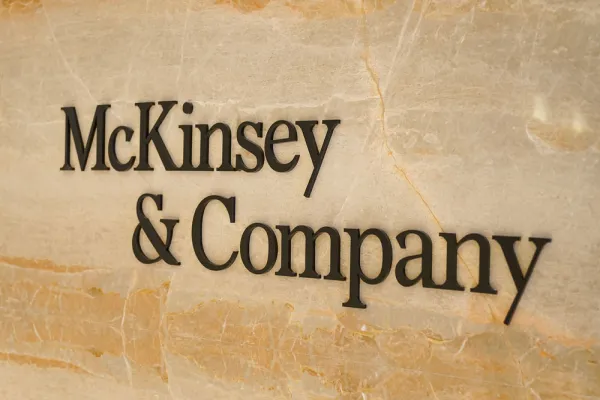On the surface, the asset management industry has fared very well over the last decade. By the end of 2021, revenues had reached a record $526 billion, performance was stellar across regions, and North America was leading the charge, with the highest growth in revenues and assets under management.
But a closer look tells a more complicated story.
According to a new report by McKinsey & Company released Friday, the performance of individual firms in North America has varied significantly, further widening the gap between the “best and the rest.”
By revenue, managers in the top quartile outperformed their peers in the bottom quartile by 29 percentage points in 2021, compared with gaps of 20 and 19 percentage points, respectively, in 2019 and 2020. With profitability, the gap was even wider: a difference of 37 percentage points between the top- and bottom-quartile performers.
Those disparities can be explained in part by the rising cost base facing the industry. Total costs for asset managers in North America grew by $71 billion over the past decade, an increase of 73.9 percent from 2012 to the end of last year. According to the report, investment management accounted for the bulk of the total at $68 billion, followed by distribution costs at $29 billion and technology at $21 billion.
“As investors have sought and asset managers have provided more complex solutions — product and vehicle innovation, usage of data and analytics, digital sales enablement, next-generation operating platforms — companies have [developed] a growing need for more, and more skilled, talent,” the report stated. Nearly half of the cost increases can be attributed to compensation: $28 billion, or 39 percent of the industry, with nearly a third of that related to investment professional head count.
Much of the increased complexity has built up within the system due to the growth of the last decade, with managers racing to capture more of that growth at the cost of gaining operating leverage.
“Very few people have taken a step back and really made the effort to clean up and rationalize their operating models to restore operating leverage into the system,” said Ju-Hon Kwek, a senior partner at McKinsey. “So I think now that [we’ve] entered 2022, you’re clearly seeing a year where a lot of those conditions get reversed. The macroeconomic conditions get reversed. The market valuations get reversed. You’re finally seeing a year where the revenues are variable, but the costs were being fixed. So that is creating a little bit of tension within the industry.”
McKinsey also stated that trends have stayed the same amid the market dislocations, with the active management strategy remaining under pressure despite the argument that major shifts in the market would herald a comeback for the strategy. The report found that roughly 55 percent of active equity managers were underperforming their benchmarks this year — in line with 2021’s performance — with $130 billion in outflows during the first half of 2022. Fixed income was also challenged, with 70 percent of assets underperforming during the same period.
In the sustainability segment, private markets were considered to have an advantage, with managers better able to secure clients through thematic strategies focused on decarbonization and energy transition. Tied to specific themes and backed by large pools of capital, these managers were able to credibly achieve returns in both financials and sustainability, according to Kwek.
The public markets, however, tell a different story. The report cautioned that uncertainty around regulations will likely result in a pause for the overall prospects of sustainable investing in the near term. “When you look at the world of publics, a lot of the products — particularly in North America — that are sustainability focused are based on a broad-based criteria [and] broad-based indices, whereas in the private markets, investors can move [more] quickly behind specific themes,” Kwek said.
McKinsey argues that this year has been a turning point for the industry.
“The Great Reset of 2022 has loosened some of the foundational assumptions behind several of the past decade’s defining trends, including the internationalization of products, clients, and capital sources; rapid growth of risk-on and leverage-oriented business models; and a wave of commoditization borne out of the surging demand for bulk beta—assumptions on which the North American asset management industry had built its growth trajectory,” according to the report.
Looking forward, McKinsey laid out three scenarios for the industry based on the Great Reset.
In what it calls a “soft landing,” central banks will be able to tame inflation, as they did in the early 1990s, and normalize supply chain distributions. In this case, the industry can expect organic growth to return to pre-pandemic levels of 2 to 5 percent per year until 2026; annualized revenue growth would be in the 5 to 10 percent range.
In a “stagnation” scenario, on the other hand, more aggressive tightening will be required, resulting in a more protracted economic slowdown with no organic growth and a strong rotation toward income- and yield-generating assets. And finally, in the case of “stagflation,” inflation will remain high, reinforced by ongoing geopolitical tensions that will further intensify disruptions to commodity prices and supply chains. The result will be a 10 to 15 percent decline in revenues over the ensuing three to five years.
“I’m an optimist about the future of the industry,” said Kwek. “I think what you’re going to see in the near term is quite significant turbulence. It’s a little bit like a forest fire, right? When it happens, it’s terrible. But what it does is clear up the undergrowth in the forest and ultimately make it a better place for trees to grow.”







